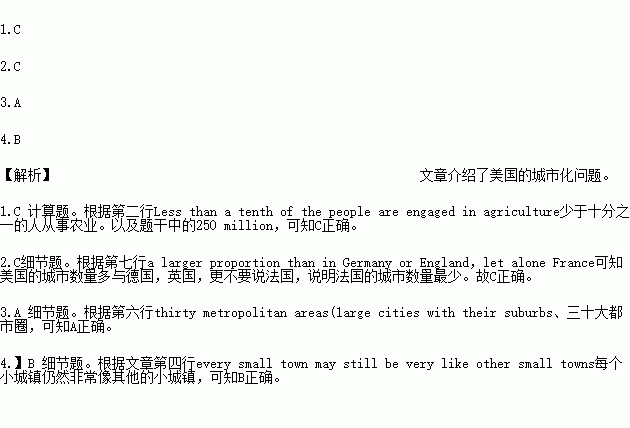题目内容
Although the United States covers so much land and the land produces far more food than the present population needs,its people are by now almost entirely an urban society Less than a tenth of the people are engaged in agriculture and forestry(林业),and most of the rest live in or around towns,small and large.Here the traditional picture is changing:every small town may still be very like other small towns,and the typical small town may represent a widely accepted view of the country,but most Americans do not live in small towns any more.Half the population now lives in some thirty metropolitan areas(1arge cities with their suburbs、of more than a million people each—a larger proportion than in Germany or England,let alone France.The statistics(统计)of urban and rural population should be treated with caution because so many people who live in areas classified as rural travel by car to work in a nearby town each day.As the rush to live out of town continues.rural areas within reach of towns are gradually filled with houses,so that it is hard to say at what moment a piece of country becomes a suburb But more and more the typical American lives in a metropolitan rather than a small town environment.
1.If now America has 250 million people.how many of them are engaged in agriculture and forestry?
A.About 25 million.
B.More than 25 million.
C.Less than 25 million.
D.Less than 225 million
2.Which of the following four countries has the smallest proportion of people living in metropolitan areas?
A.United States.
B.Germany.
C.France.
D.England.
3.What’s the meaning of the word“metropolitan”in the middle of the passage?
A.Of a large city with its suburbs.
B.Of small and large towns.
C.Of urban areas.
D.Of rural areas.
4.According to the passage,what can we learn about small towns in the United States?
A.Most small towns become gradually crowded.
B.Small towns are still similar to each other.
C.As the traditional picture is changing,towns are different.
D.Small towns are turning into large cities.
China’s Tianhe-1 has a computing speed of 2,507 trillion(万亿)calculations a second, making it the fastest computer in the world.It is also 40 percent faster than the world’s second fastest supercomputer, Cray XT5 Jaguar, in the US, kept at a national laboratory in Tennessee, according to the New York Times.Jack Dongarra, a University of Tennessee computer scientist, told NYT that the Chinese supercomputer is faster than the existing Number One machine.
Building the fastest supercomputer has become a source of national pride, as these machines are valued for their ability to solve problems in areas like defense, energy and science.These problems are related to national interests.Supercomputing technology is also found in business.Oil and gas companies use supercomputers to find oil and gas.
Obviously, research centers with large supercomputers attract top scientific talents.This adds extra importance to the machines—they’re more than just huge computers.
China’s new supercomputer will be used to speed up greatly scientific calculations, such as hurricane and tsunami modeling, cancer research, car design and even studying stars.
In 2008, two US scientists put together a step-by-step guide on how to build a supercomputer using PlayStation 3 video-game consoles(控制台).Modern supercomputers are built by combining thousands of small computer servers(服务器)and using software to turn them into one large computer.Really, any organization with enough material and technology can create a fast machine.
The Chinese system follows that model by linking thousands upon thousands of computer servers.But the secret behind the system—and the technological achievement—is China’s own networking technology.“That technology was built by them,” Dongarra said.“They are taking supercomputing very seriously and using a lot of time and money.”
“China is still a developing country,” said Sha Chaoqun, manager at Dawning Company which is the leading supercomputer maker in China.“Maybe one day, China’s total computing power can be greater than that of the US, but there is still a long way to go before we get there.”
Paragraph outline | Supporting details |
China has developed the world’s fastest supercomputer | Tianhe-1 has a high computing speed, which 1.it the fastest computer in the world. Tianhe-1 is 40 percent faster than the 2.fastest supercomputer in the world. 3.Jack Dongarra, we learn that the Chinese supercomputer is faster than existing Number One machine. |
Many countries see the fastest supercomputer as a source of national 4.and are making efforts to develop it. | The high-speed computer is 5.to solve problems relaterd to national interests. Besides 6.of defense, energy and science, supercomputing technology can also be found in business, oil and gas companies. It’s obvious that top scientific talents are 7.to research centers with large supercomputers. |
The secret behind supercomputers is networking technology | By using the technology built by Chinese people, taking it 8.and devoting lots of time and money, China has achieved a lot |
Mr.Sha showed a conservative (保守的)9.toward the development of computing power. | 10.the greater computing power China may have in the future, there is still a long way to go. |

